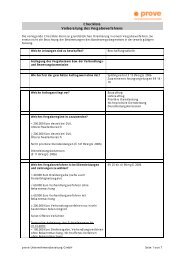Cross-programme evaluation: joint summary - Interact
Cross-programme evaluation: joint summary - Interact
Cross-programme evaluation: joint summary - Interact
You also want an ePaper? Increase the reach of your titles
YUMPU automatically turns print PDFs into web optimized ePapers that Google loves.
INTERACT<br />
Joint <strong>summary</strong> – thematic and operational aspects of cross-border cooperation in Central and South-Eastern Europe<br />
While detailed reports and executive summarise are available for each of the two studies, a number of important<br />
conclusions can be drawn from both:<br />
<br />
<br />
<br />
<br />
<br />
There are considerable differences between Territorial Cooperation <strong>programme</strong>s: Not only did operational<br />
solutions differ considerably among <strong>programme</strong>s, so did thematic orientations and types of added<br />
value generated. These differences are mainly due to the need to adapt to the various geographic and administrative<br />
settings of the <strong>programme</strong>s. Although there is ample opportunity for <strong>programme</strong>s to learn from<br />
each other, they need to translate the findings of the studies into their own context. What could work for<br />
one <strong>programme</strong> may be a very bad solution for another. It is thus not possible to single out best practices or<br />
provide benchmarks that would generally be accepted or applicable for all <strong>programme</strong>s.<br />
There are differences between EU 12 and EU 12-15 <strong>programme</strong>s: The largest differences between <strong>programme</strong>s<br />
can be observed between EU 12 <strong>programme</strong>s and EU 12-15 <strong>programme</strong>s. EU 12 <strong>programme</strong>s involve<br />
only newer member states that joined the EU during the last two rounds of accession, in 2004 and<br />
2007. EU 12-15 <strong>programme</strong>s involve also older (EU 15) member states. These two types of <strong>programme</strong>s differ<br />
with regards to both operational aspects and themes/added value generated. For instance, most EU 12<br />
<strong>programme</strong>s tend to use open calls for proposals while the EU 12-15 <strong>programme</strong>s analysed tend to favour<br />
on-going submissions of proposals. When it comes to project assessment, it was observed that EU 12-15 <strong>programme</strong>s<br />
tend to involve regional bodies in the process much more than EU 12 <strong>programme</strong>s. In terms of the<br />
thematic study, many project partners in EU12 <strong>programme</strong>s knew each other beforehand, while fewer partners<br />
previously knew each other in EU 12-15 <strong>programme</strong>s and IPA CBC <strong>programme</strong>s. Accordingly, it can be<br />
assumed that projects involving only EU 12 members can reach more substantial project achievements compared<br />
to projects involving both EU 12 and EU 15 countries, where more energy may be needed to establish<br />
cooperation routines and networks, especially since these partnerships tend to include a higher diversity of<br />
project partners compared to the projects of EU12 regions.<br />
Partnership is the key to good cooperation and value added: The success of cooperation <strong>programme</strong>s and<br />
projects depends to a large extent on the players involved. Mutual understanding and trust of the <strong>programme</strong><br />
and project partners are preconditions for a fruitful cooperation. Understanding and trust should<br />
not be taken for granted, and time and efforts are needed to establish a supportive and positive cooperation<br />
atmosphere. Programme and project partnerships can be the key to success or the main reason for failure.<br />
Defining added value is of key importance: For focused <strong>programme</strong> management and targeted decisions<br />
about projects, it is necessary to know what added value a <strong>programme</strong> wants to achieve. This includes the<br />
type of added value, the recipient of the added value and the geographical level that will be impacted.<br />
Regular reflections about the basic ambitions of a <strong>programme</strong> with regard to the different facets of added<br />
value help <strong>programme</strong>s deliver results.<br />
There is a need to remain attractive and involve new actors: <strong>Cross</strong>-border cooperation beneficiaries and<br />
potential beneficiaries have become very aware of the high administrative burden associated with managing<br />
cooperation projects. It is becoming increasingly difficult for partners with little experience to join cooperation<br />
projects, and cooperation <strong>programme</strong>s have difficulties in attracting new and suitable partners. There<br />
is a risk of crowding out certain types of actors, due to a bias for experienced partners. This issue became<br />
evident in both studies and was quantified in the thematic study, where it is shown that more than 50% of<br />
the project partners have previously cooperated with most or all of their current project partners. Certainly,<br />
some continuation of cooperation over an extended period of time is needed, to maximise benefits of<br />
cooperation and to build upon prior common work. At project level, mature partnerships are also often perceived<br />
as successful and more result-oriented, while young partnerships often need a substantial amount of<br />
time to establish mutual trust between the cooperation partners. However, if the demands towards the projects<br />
are too high, and the <strong>programme</strong>s do not allow and support young and inexperienced partnerships to<br />
test and learn cooperation, there is a risk that cross-border cooperation will develop into a closed shop.<br />
- 9 -
















